Surface Adsorption Properties and Layer Structures of Homogeneous Polyoxyethylene-Type Nonionic Surfactants in Quaternary-Ammonium-Salt-Type Amphiphilic Gemini Ionic Liquids with Oxygen- or Nitrogen-Containing Spacers
Abstract
1. Introduction
2. Results and Discussion
2.1. Solubilities of Nonionic Surfactants in Quaternary-Ammonium-Salt-Type Amphiphilic Gemini Ionic Liquids
2.2. Surface Adsorption Behavior of Surfactants in Amphiphilic Gemini Ionic Liquids
2.3. Layer Structure of Amphiphilic Gemini Ionic Liquids
2.4. Layer Structure of Amphiphilic Gemini Ionic Liquids and Nonionic Surfactants
3. Materials and Methods
3.1. Materials
3.2. Phase-Separation Temperature
3.3. Surface Tension
3.4. SAXS and WAXS
3.5. Viscosity
4. Conclusions
Supplementary Materials
Author Contributions
Funding
Acknowledgments
Conflicts of Interest
References
- Welton, T. Room-temperature ionic liquids. Solvents for synthesis and catalysis. Chem. Rev. 1999, 99, 2071–2084. [Google Scholar] [CrossRef]
- Wilkes, J.S. A short history of ionic liquids—From molten salts to neoteric solvents. Green Chem. 2002, 4, 73–80. [Google Scholar] [CrossRef]
- Dupont, J.; de Souza, R.F.; Suarez, P.A.Z. Ionic liquid (molten salt) phase organometallic catalysis. Chem. Rev. 2002, 102, 3667–3692. [Google Scholar] [CrossRef]
- Gordon, C.M. New developments in catalysis using ionic liquids. Appl. Catal. A 2001, 222, 101–107. [Google Scholar] [CrossRef]
- Seddon, K.R. Ionic liquids for clean technology. J. Chem. Technol. Biotechnol. 1997, 68, 351–356. [Google Scholar] [CrossRef]
- Chamiot, B.; Rizzi, C.; Gaillon, L.; Sirieix-Plénet, J.; Lelièvre, J. Redox-switched amphiphilic ionic liquid behavior in aqueous solution. Langmuir 2009, 25, 1311–1315. [Google Scholar] [CrossRef] [PubMed]
- Bradley, A.E.; Hardacre, C.; Holbrey, J.D.; Johnston, S.; McMath, S.E.J.; Nieuwenhuyzen, M. Small-angle X-ray scattering studies of liquid crystalline 1-alkyl-3-methylimidazolium salts. Chem. Mater. 2002, 14, 629–635. [Google Scholar] [CrossRef]
- Triolo, A.; Russina, O.; Bleif, H.J.; Di Cola, E. Nanoscale segregation in room temperature ionic liquids. J. Phys. Chem. B 2007, 111, 4641–4644. [Google Scholar] [CrossRef]
- Fujii, K.; Kanzaki, R.; Takamuku, T.; Kameda, Y.; Kohara, S.; Kanakubo, M.; Shibayama, M.; Ishiguro, S.; Umebayashi, Y. Experimental evidences for molecular origin of low-Q peak in neutron/X-ray scattering of 1-alkyl-3-methylimidazolium bis(trifluoromethanesulfonyl)amide ionic liquids. J. Chem. Phys. 2011, 135, 244502. [Google Scholar] [CrossRef]
- Kofu, M.; Nagao, M.; Ueki, T.; Kitazawa, Y.; Nakamura, Y.; Sawamura, S.; Watanabe, M.; Yamamuro, O. Heterogeneous slow dynamics of imidazolium-based ionic liquids studied by neutron spin echo. J. Phys. Chem. B 2013, 117, 2773–2781. [Google Scholar] [CrossRef]
- Shimizu, K.; Bernardes, C.E.S.; Canongia Lopes, J.N. Structure and aggregation in the 1-alkyl-3-methylimidazolium bis(trifluoromethylsulfonyl)imide ionic liquid homologous series. J. Phys. Chem. B 2014, 118, 567–576. [Google Scholar] [CrossRef]
- Bowlas, C.J.; Bruce, D.W.; Seddon, K.R. Liquid-crystalline ionic liquids. Chem. Commun. 1996, 1625–1626. [Google Scholar] [CrossRef]
- Yoshio, M.; Mukai, T.; Kanie, K.; Yoshizawa, M.; Ohno, H.; Kato, T. Layered ionic liquids: Anisotropic ion conduction in new self-organized liquid-crystalline materials. Adv. Mater. 2002, 14, 351–354. [Google Scholar] [CrossRef]
- Bruce, D.W.; Cabry, C.P.; Canongia Lopes, J.N.; Costen, M.L.; D’Andrea, L.; Grillo, I.; Marshall, B.C.; McKendrick, K.G.; Minton, T.K.; Purcell, S.M.; et al. Nanosegregation and structuring in the bulk and at the surface of ionic-liquid mixtures. J. Phys. Chem. B 2017, 121, 6002–6020. [Google Scholar] [CrossRef]
- Canongia Lopes, J.N.A.; Pádua, A.A.H. Nanostructural organization in ionic liquids. J. Phys. Chem. B 2006, 110, 3330–3335. [Google Scholar] [CrossRef]
- Pádua, A.A.H.; Costa Gomes, M.F.; Canongia Lopes, J.N.A. Molecular solutes in ionic liquids: A structural perspective. Acc. Chem. Res. 2007, 40, 1087–1096. [Google Scholar] [CrossRef]
- Kawai, R.; Yada, S.; Yoshimura, T. Characterization and solution properties of quaternary-ammonium-salt-type amphiphilic gemini ionic liquids. ACS Omega 2019, 4, 14242–14250. [Google Scholar] [CrossRef] [PubMed]
- Kawai, R.; Yada, S.; Yoshimura, T. Surface adsorption and bulk properties of surfactants in quaternary-ammonium-salt-type amphiphilic monomeric and gemini ionic liquids. Langmuir 2020, 36, 5219–5226. [Google Scholar] [CrossRef]
- Kawai, R.; Niki, M.; Yada, S.; Yoshimura, T. Physicochemical and solution properties of quaternary-ammonium-salt-type amphiphilic gemini ionic liquids with spacers containing oxygen or nitrogen. Colloids Surf. A 2020, 603, 125218. [Google Scholar] [CrossRef]
- Kawai, R.; Yada, S.; Yoshimura, T. Physicochemical and solution properties of quaternary-ammonium-salt-type amphiphilic trimeric ionic liquids. Phys. Chem. Chem. Phys. 2019, 21, 25065–25071. [Google Scholar] [CrossRef]
- Ren, Y.; Zhao, B.; Chang, Q.; Yao, X. QSPR modeling of nonionic surfactant cloud points: An update. J. Colloid Interface Sci. 2011, 358, 202–207. [Google Scholar] [CrossRef] [PubMed]
- Rosen, M.J.; Kunjappu, J.T. Solubilization by solutions of surfactants: Micellar catalysis. In Surfactants and Interfacial Phenomena, 4th ed.; John Wiley and Sons, Inc.: Hoboken, NJ, USA, 2012; pp. 202–234. [Google Scholar]
- Inoue, T.; Misono, T. Cloud point phenomena for POE-type nonionic surfactants in a model room temperature ionic liquid. J. Colloid Interface Sci. 2008, 326, 483–489. [Google Scholar] [CrossRef] [PubMed]
- Tanford, C. Micelle shape and size. J. Phys. Chem. 1972, 76, 3020–3024. [Google Scholar] [CrossRef]
Sample Availability: Samples of the amphiphilic gemini ionic liquids 2Cn(Spacer) NTf2 are available from the authors. |
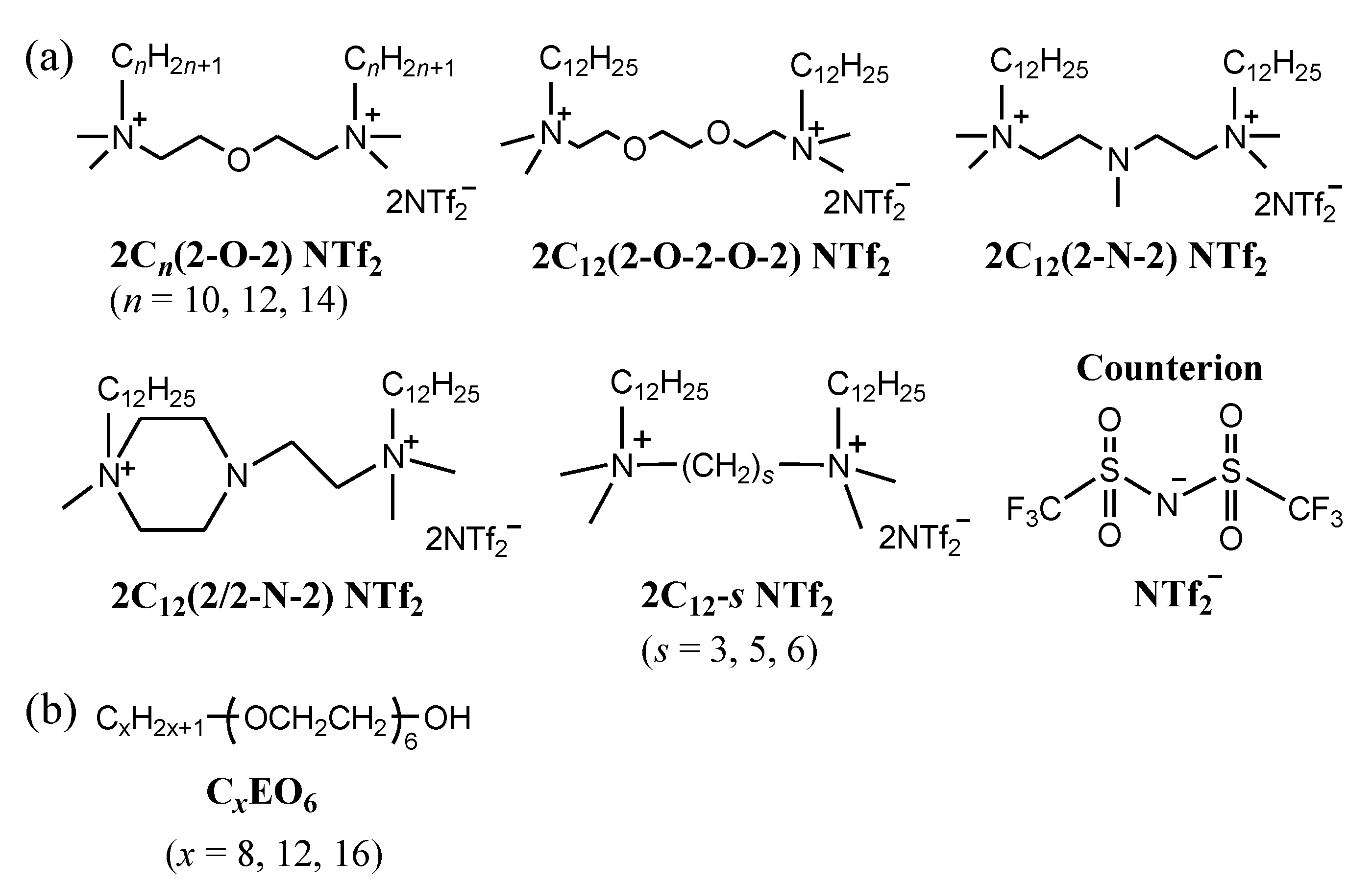
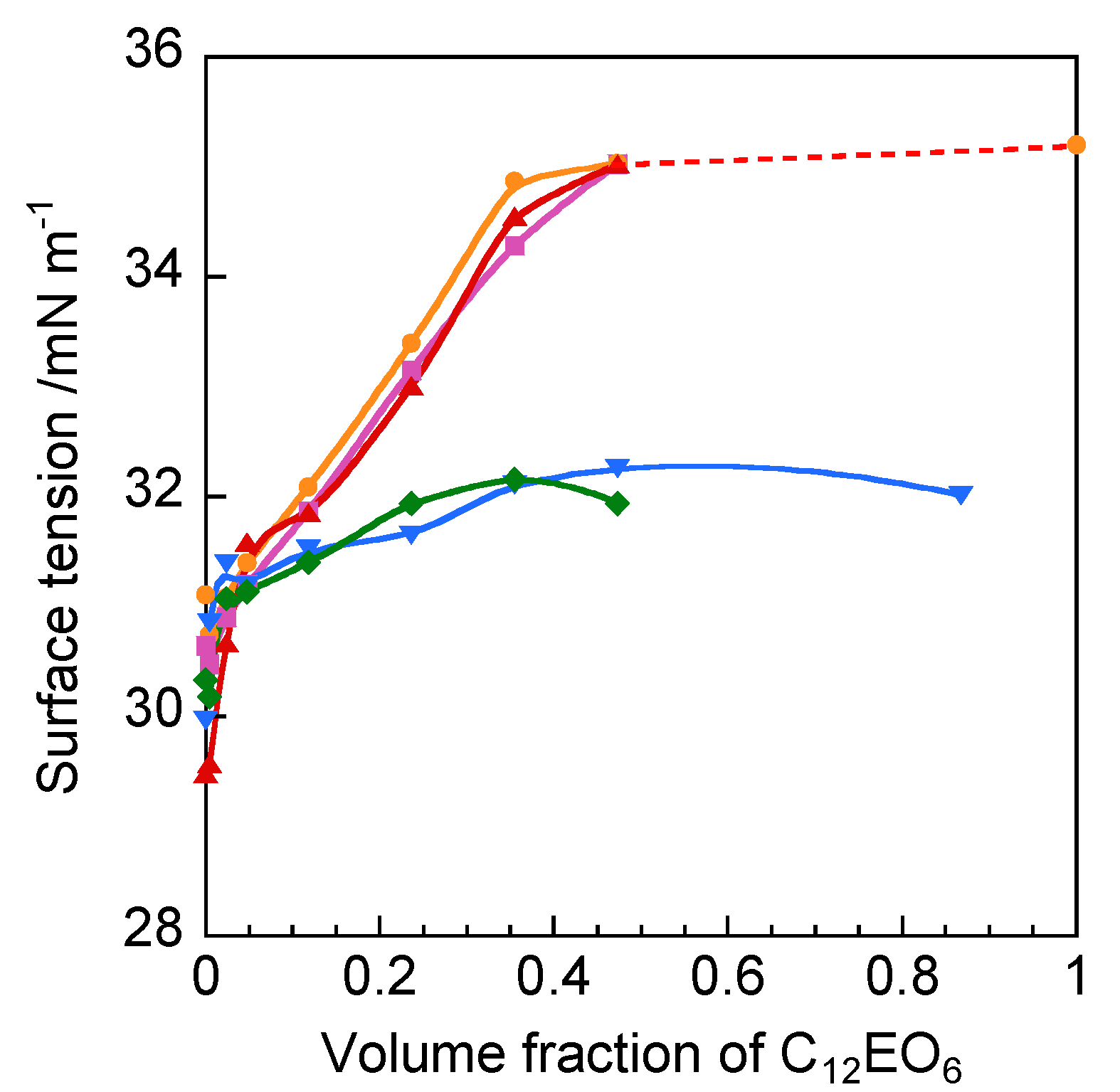
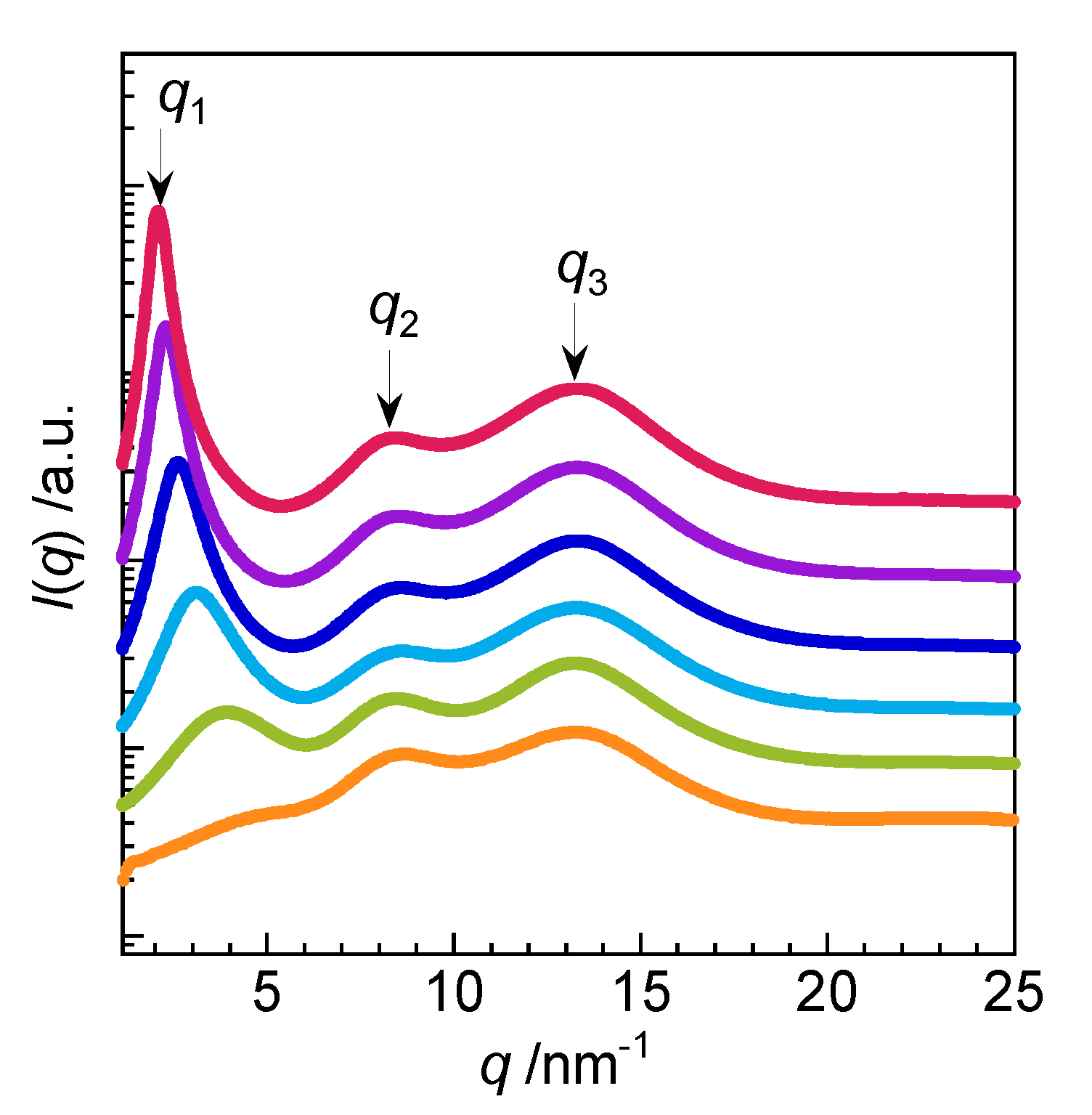
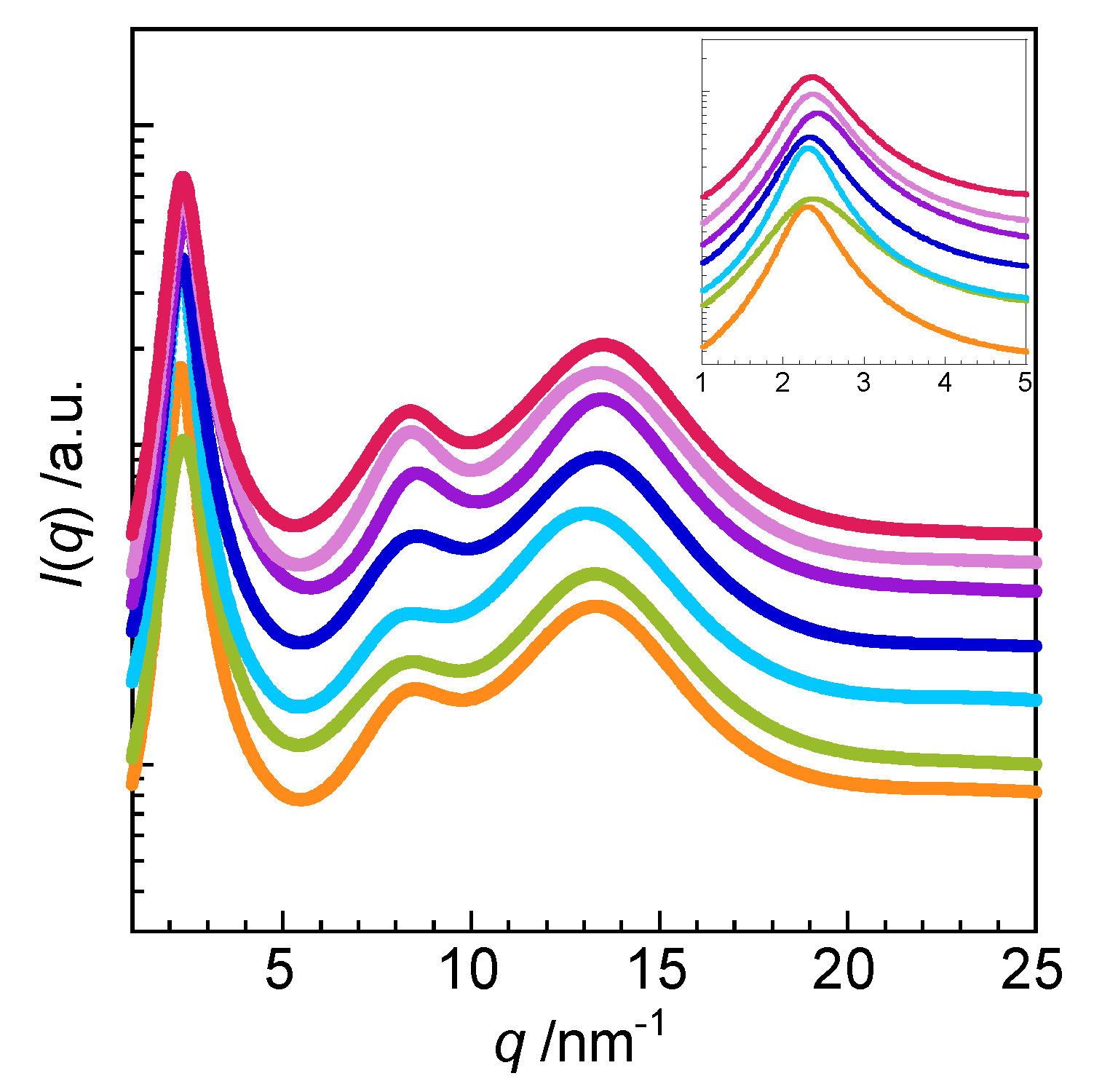
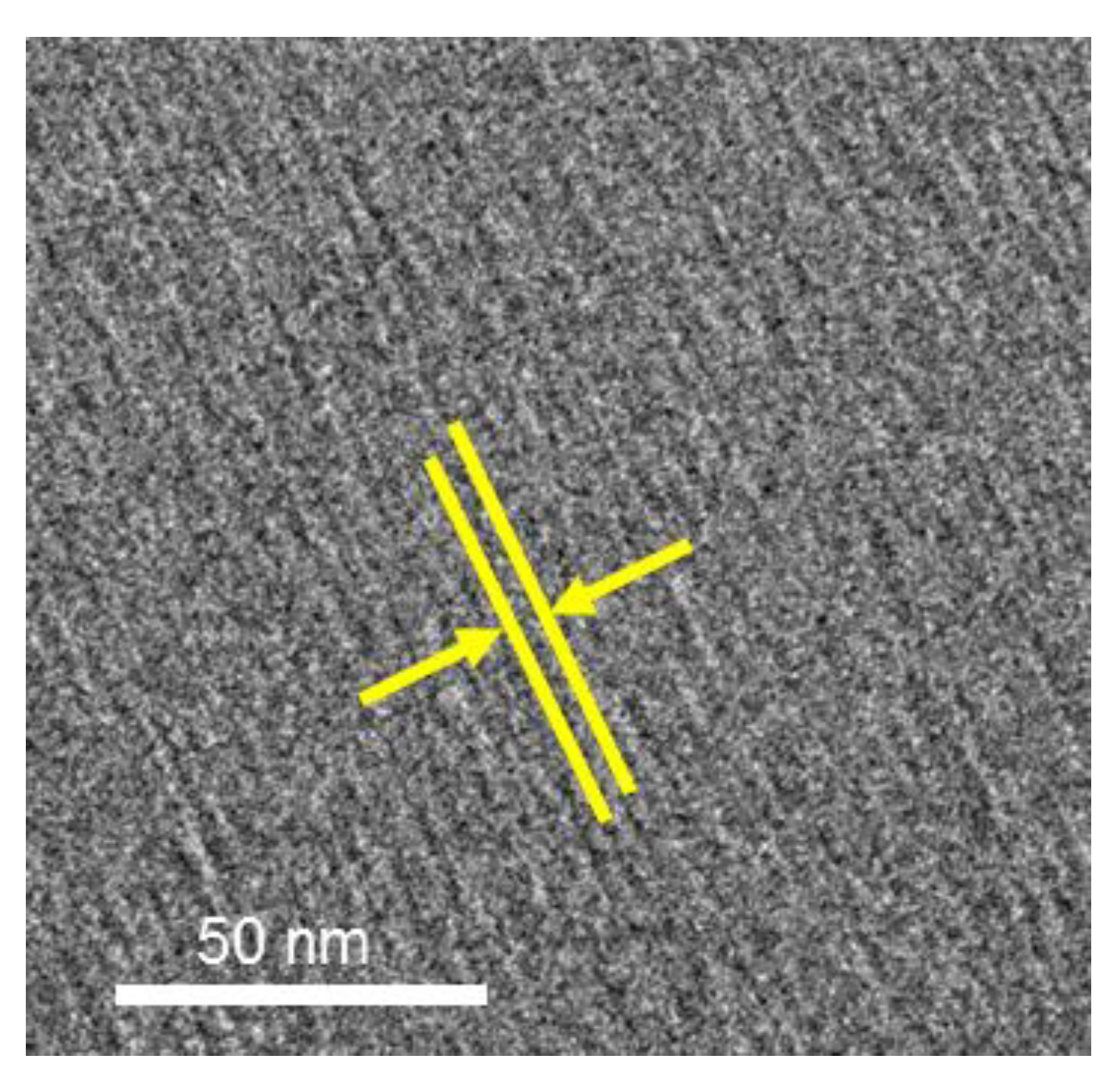
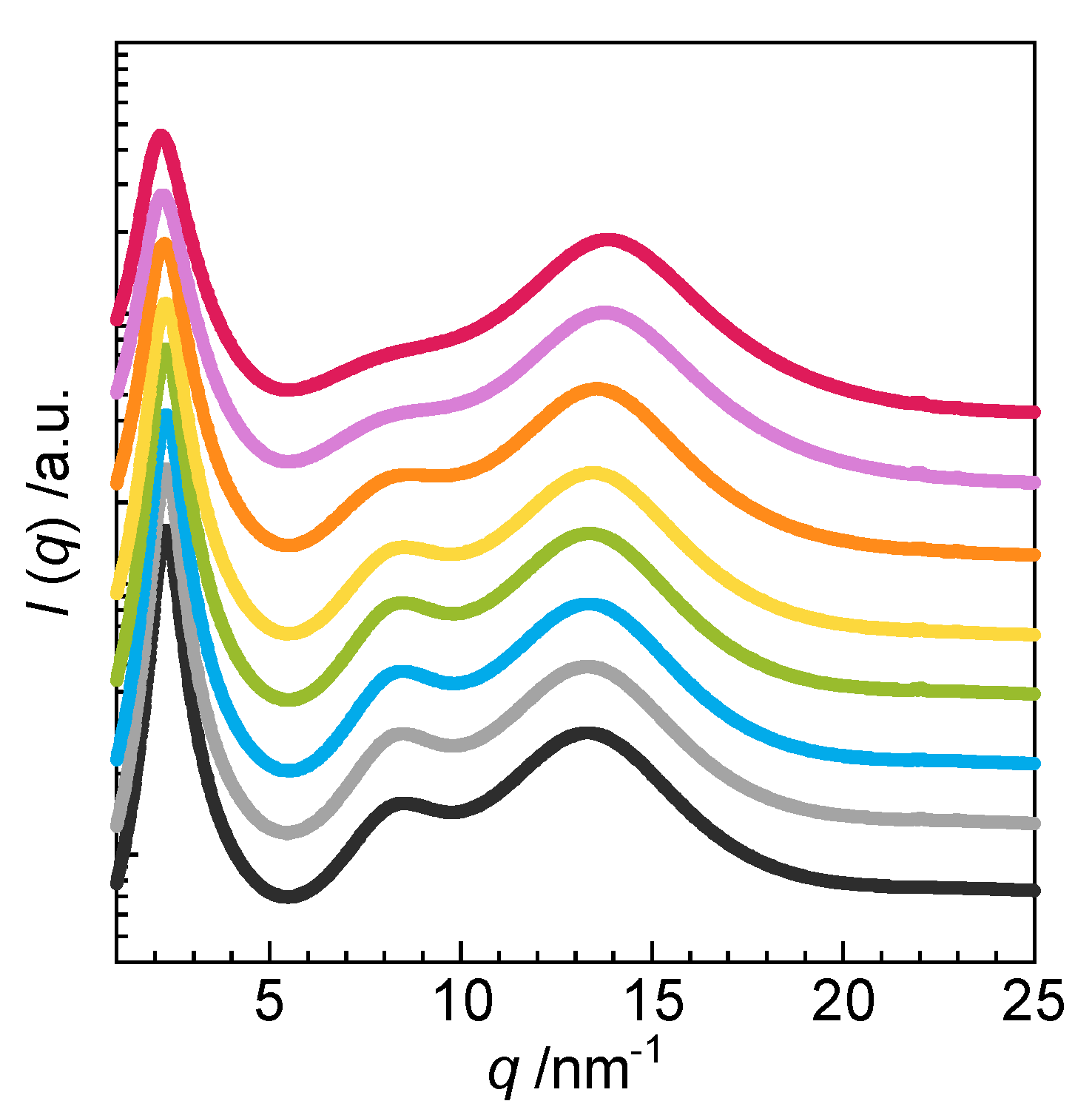
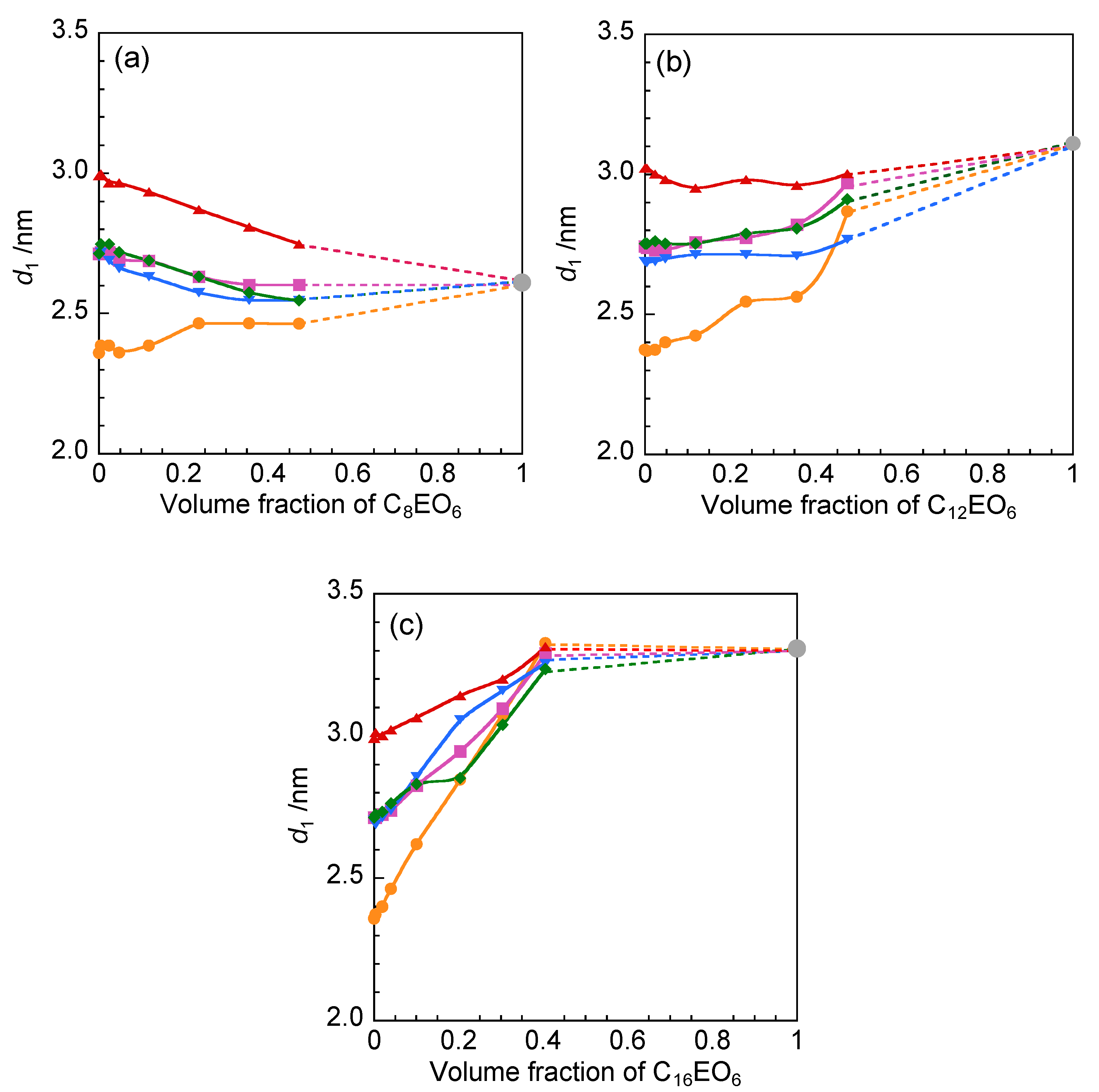

| Spacer | d1/nm | d2/nm | d3/nm |
|---|---|---|---|
| (2-O-2) | 2.74 | 0.74 | 0.47 |
| (2-O-2-O-2) | 2.65 | 0.74 | 0.47 |
| (2-N-2) | 2.72 | 0.73 | 0.47 |
| (2/2-N-2) | 2.72 | 0.74 | 0.48 |
| (3) | 2.59 | 0.73 | 0.47 |
| (5) | 2.65 | 0.75 | 0.47 |
| (6) | 2.67 | 0.75 | 0.46 |
Publisher’s Note: MDPI stays neutral with regard to jurisdictional claims in published maps and institutional affiliations. |
© 2020 by the authors. Licensee MDPI, Basel, Switzerland. This article is an open access article distributed under the terms and conditions of the Creative Commons Attribution (CC BY) license (http://creativecommons.org/licenses/by/4.0/).
Share and Cite
Kawai, R.; Niki, M.; Yada, S.; Yoshimura, T. Surface Adsorption Properties and Layer Structures of Homogeneous Polyoxyethylene-Type Nonionic Surfactants in Quaternary-Ammonium-Salt-Type Amphiphilic Gemini Ionic Liquids with Oxygen- or Nitrogen-Containing Spacers. Molecules 2020, 25, 4881. https://doi.org/10.3390/molecules25214881
Kawai R, Niki M, Yada S, Yoshimura T. Surface Adsorption Properties and Layer Structures of Homogeneous Polyoxyethylene-Type Nonionic Surfactants in Quaternary-Ammonium-Salt-Type Amphiphilic Gemini Ionic Liquids with Oxygen- or Nitrogen-Containing Spacers. Molecules. 2020; 25(21):4881. https://doi.org/10.3390/molecules25214881
Chicago/Turabian StyleKawai, Risa, Maiko Niki, Shiho Yada, and Tomokazu Yoshimura. 2020. "Surface Adsorption Properties and Layer Structures of Homogeneous Polyoxyethylene-Type Nonionic Surfactants in Quaternary-Ammonium-Salt-Type Amphiphilic Gemini Ionic Liquids with Oxygen- or Nitrogen-Containing Spacers" Molecules 25, no. 21: 4881. https://doi.org/10.3390/molecules25214881
APA StyleKawai, R., Niki, M., Yada, S., & Yoshimura, T. (2020). Surface Adsorption Properties and Layer Structures of Homogeneous Polyoxyethylene-Type Nonionic Surfactants in Quaternary-Ammonium-Salt-Type Amphiphilic Gemini Ionic Liquids with Oxygen- or Nitrogen-Containing Spacers. Molecules, 25(21), 4881. https://doi.org/10.3390/molecules25214881






